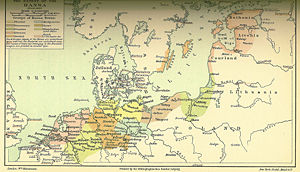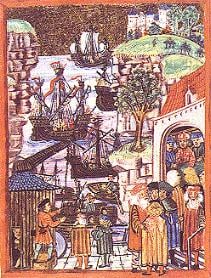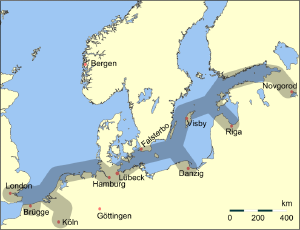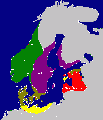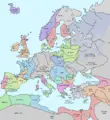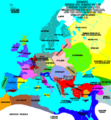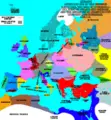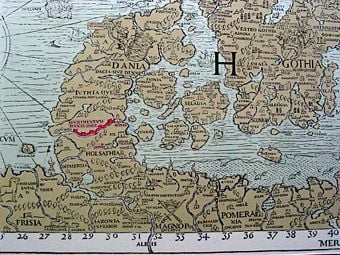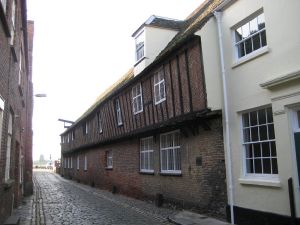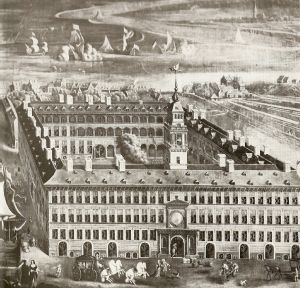Difference between revisions of "Hanseatic League" - New World Encyclopedia
| Line 23: | Line 23: | ||
===Expansion=== | ===Expansion=== | ||
[[Image:Haupthandelsroute Hanse.png|thumb|Main trading routes of the Hanseatic League.]] | [[Image:Haupthandelsroute Hanse.png|thumb|Main trading routes of the Hanseatic League.]] | ||
| − | Lübeck's location on the Baltic provided access for trade with [[Scandinavia]] and [[History of Russia|Russia]], putting it in direct competition with the Scandinavians who had previously controlled most of the Baltic trade routes. A treaty with the Visby Hansa put an end to competition: through this treaty the Lübeck merchants also gained access to the inland Russian port of [[Novgorod Republic|Novgorod]], where they built a trading post or ''[[Kontor]]''. Other such alliances formed throughout the [[Holy Roman Empire]]. The League never became a closely-managed formal organisation. Assemblies of the Hanseatic towns met irregularly in Lübeck for a ''Hansetag'', from 1356 onwards, but many towns chose not to send representatives and decisions were not binding individual cities.Over time, the network of alliances grew to include a flexible roster of 70 to 170 cities. | + | Lübeck's location on the Baltic provided access for trade with [[Scandinavia]] and [[History of Russia|Russia]], putting it in direct competition with the Scandinavians who had previously controlled most of the Baltic trade routes. A treaty with the Visby Hansa put an end to competition: through this treaty the Lübeck merchants also gained access to the inland Russian port of [[Novgorod Republic|Novgorod]], where they built a trading post or ''[[Kontor]]''. Other such alliances formed throughout the [[Holy Roman Empire]]. The League never became a closely-managed formal organisation. Assemblies of the Hanseatic towns met irregularly in Lübeck for a ''Hansetag'', from 1356 onwards, but many towns chose not to send representatives and decisions were not binding individual cities.Over time, the network of alliances grew to include a flexible roster of 70 to 170 cities.<ref name=Baudel> |
The league succeeded in establishing additional ''Kontors'' in [[Bruges]] ([[County of Flanders|Flanders]]), [[Bergen, Norway|Bergen]] (Norway), and [[London]] (England). These trading posts became significant [[enclave]]s. The London ''Kontor'', established in 1320, stood west of [[London Bridge]] near Upper Thames Street. ([[Cannon Street station]] occupies the site [[as of 2006|now]].) It grew significantly over time into a walled community with its own warehouses, weighhouse, church, offices and houses, reflecting the importance and scale of the activity carried on. The first reference to it as the [[Steelyard]] ''(der Stahlhof)'' occurs in 1422. | The league succeeded in establishing additional ''Kontors'' in [[Bruges]] ([[County of Flanders|Flanders]]), [[Bergen, Norway|Bergen]] (Norway), and [[London]] (England). These trading posts became significant [[enclave]]s. The London ''Kontor'', established in 1320, stood west of [[London Bridge]] near Upper Thames Street. ([[Cannon Street station]] occupies the site [[as of 2006|now]].) It grew significantly over time into a walled community with its own warehouses, weighhouse, church, offices and houses, reflecting the importance and scale of the activity carried on. The first reference to it as the [[Steelyard]] ''(der Stahlhof)'' occurs in 1422. | ||
Revision as of 22:55, 2 August 2008
The Hanseatic League (also known as the Hansa) was an alliance of trading guilds that established and maintained a trade monopoly along the coast of Northern Europe, from the Baltic to the North Sea, during the Late Middle Ages and Early modern period (Circa 13th]]–17th centuries). Rival cities cooperated within the League to defend themselves from pirates as well as to compete against larger economic powers. The League is widely regarded as a forerunner of the European Community both as a free trade zone and as an entity that had to balance the interests of the larger polity with the identities and interests of its members on the other.[1][2] For almost four centuries, the League maintained its own military, an exchange mechanism, regulated tariffs and even had a Parliament (Diet, the Hansetage), although this met infrequently. There were also regional and district diets. The League aimed to protect trade, which meant that maintaining peace was also a major concern. It sometimes waged war but favored peace. The making of war and peace was discussed in the Diet. Unlike the EU, though, for most of its history the League had no permanent official; it was not until 1556 that Heinrich Suderman was appointed Syndic, (representative).[3]The League's decline has been attributed to increased competition from England, Netherlands, Denmark and Sweden as these states grew more powerful and to social unrest resulting from the Protestant Reformation. By 1648, some Hanseatic towns had fallen to Sweden and merchants had been expelled from Holland. The League, however, was included in the Peace of Westphalia when it was mentioned for the first time in "an official document of the Holy Roman Empire".[3]. On the one hand, the League's prosperity probably did not trickle down to the non-elite of its cities. On the other hand, for much of its history, all citizens enjoyed long periods of peace and stability based almost exclusively on its preference for trade over war. The founding fathers of the European Union were also convinced that trade, resource sharing and economic convergence would prevent war and promote peace. Behind this stands the achievements of the Hanseatic League.
History
Historians generally trace the origins of the League to the rebuilding of the North German town of Lübeck in 1159 by Duke Henry the Lion of Saxony, after Henry had captured the area from Count Adolf II of Holstein.
Exploratory trading adventures, raids and piracy had happened earlier throughout the Baltic (see Vikings) — the sailors of Gotland sailed up rivers as far away as Novgorod, for example — but the scale of international economy in the Baltic area remained insignificant before the growth of the Hanseatic League.
German cities achieved domination of trade in the Baltic with striking speed over the next century, and Lübeck became a central node in all the sea-borne trade that linked the areas around the North Sea and the Baltic Sea. The 15th century saw the climax of Lübeck's hegemony. Visby, one of the midwives of the Hanseatic League in 1358, declined to become a member. Visby dominated trade in the Baltic before the Hanseatic League, and with its monopolistic ideology, suppressed the Gotlandic free-trade competition.
Foundation
Lübeck became a base for merchants from Saxony and Westphalia to spread east and north. Well before the term Hanse appeared in a document (1267), merchants in a given city began to form guilds or Hansa with the intention of trading with towns overseas, especially in the less-developed eastern Baltic area, a source of timber, wax, amber, resins, furs, even rye and wheat brought down on barges from the hinterland to port markets.
Visby functioned as the leading centre in the Baltic before the Hansa. For 100 years the Germans sailed under the Gotlandic flag to Novgorod. Sailing east, Visby merchants established a branch at Novgorod. To begin with the Germans used the Gotlandic Gutagard. With the influx of too many merchants the Gotlanders arranged their own trading stations for the German Petershof further up from the river—see a translation of the grant[4] of privileges to merchants in 1229. Before the foundation of the Hanseatic league in 1358 the word Hanse did not occur in the Baltic. The Gotlanders used the word varjag.
Hansa societies worked to acquire special trade privileges for their members. For example, the merchants of the Cologne Hansa contrived to convince Henry II of England to grant them (1157) special trading privileges and market rights which freed them from all London tolls and allowed them to trade at fairs throughout England. The "Queen of the Hansa," Lübeck, where traders trans-shipped goods between the North Sea and the Baltic, gained the Imperial privilege of becoming an Imperial city in 1227, the only such city east of the River Elbe.
Lübeck, which had access to the Baltic and North Sea fishing grounds, formed an alliance in 1241 with Hamburg, another trading city, which controlled access to salt-trade routes from Lüneburg. The allied cities gained control over most of the salt-fish trade, especially the Scania Market; and Cologne joined them in the Diet of 1260. In 1266 Henry III of England granted the Lübeck and Hamburg Hansa a charter for operations in England, and the Cologne Hansa joined them in 1282 to form the most powerful Hanseatic colony in London. Much of the drive for this co-operation came from the fragmented nature of existing territorial government, which failed to provide security for trade. Over the next 50 years the Hansa itself emerged with formal agreements for confederation and co-operation covering the west and east trade routes. The chief city and linchpin remained Lübeck; with the first general Diet of the Hansa held there in 1356, the Hanseatic League acquired an official structure and could date its official founding.
Expansion
Lübeck's location on the Baltic provided access for trade with Scandinavia and Russia, putting it in direct competition with the Scandinavians who had previously controlled most of the Baltic trade routes. A treaty with the Visby Hansa put an end to competition: through this treaty the Lübeck merchants also gained access to the inland Russian port of Novgorod, where they built a trading post or Kontor. Other such alliances formed throughout the Holy Roman Empire. The League never became a closely-managed formal organisation. Assemblies of the Hanseatic towns met irregularly in Lübeck for a Hansetag, from 1356 onwards, but many towns chose not to send representatives and decisions were not binding individual cities.Over time, the network of alliances grew to include a flexible roster of 70 to 170 cities.Cite error: Closing </ref> missing for <ref> tag He held the speech in Bad Schwartau, a small village on the outskirts of Lübeck. Subsequently, he referred to Lübeck as "the small city close to Bad Schwartau."
Historical maps
Lists of former Hansa cities
In the list that follows, the role of these foreign merchant companies in the functioning of the city that was their host, in more than one sense is, as Fernand Braudel[5] pointed out, a telling criterion of the status of that city: "If he rules the roost in a given city or region, the foreign merchant is a sign of the [economic] inferiority of that city or region, compared with the economy of which he is the emissary or representative."
Members of the Hanseatic League
Wendish Circle
- Lübeck (chief city)
- Greifswald
- Hamburg
- Kiel
- Lüneburg
- Rostock
- Stade
- Stettin (Szczecin)
- Stralsund
- Wismar
Saxony, Thuringia, Brandenburg Circle
|
|
Poland, Prussia, Livonia, Sweden Circle
- Breslau (Wrocław)
- Danzig (Gdańsk, chief city)
- Dorpat (Tartu)
- Elbing (Elbląg)
- Fellin (Viljandi)
- Kraków (Cracow)
- Goldingen (Kuldīga)
- Kokenhusen (Koknese)
- Königsberg (now Kaliningrad)
- Lemsal (Limbaži)
- Pernau (Pärnu)
- Reval (Tallinn)
- Riga (Rīga, chief city)
- Roop (Straupe)
- Stockholm
- Thorn (Toruń)
- Visby
- Wenden (Cēsis)
- Windau (Ventspils)
- Wolmar (Valmiera)
Rhine, Westphalia, the Netherlands Circle
- Duisburg
- Zwolle
- Haltern am See
- Hattem
- Hasselt
- Hattingen
- Cologne
- Dortmund (chief city)
- Soest
- Osnabrück
- Münster
- Coesfeld
- Roermond
- Deventer, with subsidiary cities:
- Ommen
- Enschede
- Oldenzaal
- Hasselt
- Gramsbergen
- Groningen
- Kampen
- Bochum
- Recklinghausen
- Hamm
- Unna
- Werl
- Zutphen
- Breckerfeld
- Minden
Counting houses
Principal Kontore
- Bergen - Bryggen
- Brugge - (Bruges)
- Steelyard - district of London
- Novgorod - Velikiy Novgorod, Russia
Subsidiary Kontore
- Antwerp
- Berwick upon Tweed
- Boston
- Damme
- Edinburgh
- Hull
- Ipswich
- King's Lynn
- Kaunas
- Newcastle
- Polotsk
- Pskov
- Great Yarmouth
- York
Other cities with a Hansa community
|
|
Legacy
The legacy of the League lives on in the concept and practice of free trade as well as in the idea of forging trans-national entities that cooperate not only in matters of trade and economics but also in defense and peace-keeping with a view to establishing greater fiscal and social equality. The degree to which the League benefited the non-elite is debatable. However, as an alliance of cities, it drew together political entities that were usually governed by members of the guilds, who were commoners not by aristocrats. The League could only function because a standard legal system existed across its member cities, as did a strong tradition of civil and individual rights and liberties. Porten, writing in 1994, describes the League as succeeding in creating "a largely, peaceful, international network of finance and trade", adding, "Not until our own time, when the member nations of the Common Market (now the European Union) vowed to open borders, merge currencies, and create a single, unified market, would the Continent see anything like it."[2] The League was a protectionist alliance that promoted the welfare of its members but did not extend their concern beyond their boundaries. It was this protectionist policy that angered foreign, non-League merchants and their countries. Several German cities including Hamburg and Bremen (home of the Hanseatic Museum) continue to use "Hanse" as part of their official names (Freie und Hansestadt; Free and Hanseatic) and some, including Wismar and Rostock have recently added this to revive interest in their historic link with the League. The Hanseatic colors of silver and red are also still used for some civic emblems. The standardization of sea trade and of trade regulations derives from the League.
Fictional references
- A Terran Hanseatic League exists in Kevin J. Anderson's science fiction series, Saga of Seven Suns. The political structure of this fictional interstellar version closely resembles that of the historical Hanseatic League.Cite error: Closing
</ref>missing for<ref>tag - In the Perry Rhodan SF series, the trade organisation the Cosmic Hansa (Kosmische Hanse) covers the Galaxy. The English translation for this organisation is Cosmic House (see American issues 1800-1803) as it was felt that no one would understand the Hanseatic League reference.[6]
- Midgard open source content management system has often been referred to as the Hanseatic League of Open Source.[7]
Hanseatic League merchant caravans are used as the backdrop for "living history" groups in Florida and North Carolina. has two chapters, "Bergens Kontor" in Fort Lauderdale, Florida, and "Voss Kontor" in Fayetteville, North Carolina. Both groups portray merchants from a Hanseatic League merchant caravan originating from kontors and towns in Norway. They offer "in character" lectures, skits and "theatre in the round," based on the history of the Hanseatic League, for the education and entertainment of Renaissance Festival patrons and local schools.[8]
Robert Heinlein's novel, Citizen of the Galaxy, revolves around a loose league of trading spaceships of varying old Earth nationalities like the Finns aboard the "Sisu." Another ship is called "Hansea."[9]
Barrie Jay Moynihan refers to the Hanseatic League in his recently withdrawn fiction novel with describes the dilemmas presented to a local landowner Fergus Crothur Ceilleacher who was based in hinterland of Tralee during the Act of Union 1601.
Notes
- ↑ Brand, Hanno. 2007. Weaknesses and Strength of the Hanseatic League. Groningen: INTERREG IIIC. Retrieved August 2, 2008.
- ↑ 2.0 2.1 Porten, Edward Von der. 1994. Hanseatic League: Europe's First Common Market. National Geographic Magazine. October, No: 05953. Retrieved August 2, 2008.
- ↑ 3.0 3.1 Post, Rainer. 1996. The Hanseatic League and its Decline. Bundeswehr Universität. Retrieved August 2, 2008. Cite error: Invalid
<ref>tag; name "Post" defined multiple times with different content - ↑ Medieval Sourcebook: Privileges Granted to German Merchants at Novgorod, 1229 Fordham University Medieval Sourcebook, from: G. F. Sartorius, ed., Urkundliche Geschichte des Ursprunges der Deutschen Hanse, J. M. Lappenberg, rev., (Hamburg, 1830), Vol. II, p. 29; reprinted in Roy C. Cave & Herbert H. Coulson, eds. 1965. A Source Book for Medieval Economic History. Milwaukee: The Bruce Publishing Co., 1936; reprint ed., New York: Biblo & Tannen, 1965), pp. 225-231. Retrieved August 2, 2008.
- ↑ Braudel, Fernand Civilization and Capitalism, 15th - 18th Century. NY: Columbia University Press ISBN 9780520081161 page 40.
- ↑ The longest running Science Fiction series, the first Perry Rhodan installment was published in Germany in 1961. The official homepage, in German, is Perry Rhoden.] Perry-rhodan.net. Retrieved August 2, 2008.
- ↑ Midgard CMS. Midgard-project.org. Retrieved August 2, 2008.
- ↑ Hanseatic League Historical Re-enactors Hanseatic-league.com. Retrieved August 2, 2008.
- ↑ Heinlein, Robert A. 1957. NY: Scribner. ISBN 9780575002067.
ReferencesISBN links support NWE through referral fees
- Dollinger, Philippe. 1970. The German Hansa. Stanford, CA: Stanford University Press. ISBN 9780804707428
- Lavery, Jason Edward. 2002. Germany's northern challenge: the Holy Roman Empire and the Scandinavian struggle for the Baltic, 1563-1576. Studies in Central European histories. Boston: Brill Academic. ISBN 9780391041561
- Lloyd, T. H. 1991. England and the German Hanse, 1157-1611: a study of their trade and commercial diplomacy. Cambridge [England]: Cambridge University Press.ISBN 9780521404426
- Nash, Elizabeth G The Hansa.. NY: Barnes and Noble. ISBN 9781566198677
- Øye, Ingvild. 1994. Bergen and the German Hansa. Bergen: Bryggens Museum.ISBN 9788290289527
External links
- Chronology
- Hanseatic Cities in The Netherlands / Holland
- Hanseatic League Historical Re-enactors
- Hanseatic Towns Network
- Hanseatic League related sources in the German Wikisource
- Colchester a Hanseatic port - Gresham
Credits
New World Encyclopedia writers and editors rewrote and completed the Wikipedia article in accordance with New World Encyclopedia standards. This article abides by terms of the Creative Commons CC-by-sa 3.0 License (CC-by-sa), which may be used and disseminated with proper attribution. Credit is due under the terms of this license that can reference both the New World Encyclopedia contributors and the selfless volunteer contributors of the Wikimedia Foundation. To cite this article click here for a list of acceptable citing formats.The history of earlier contributions by wikipedians is accessible to researchers here:
The history of this article since it was imported to New World Encyclopedia:
Note: Some restrictions may apply to use of individual images which are separately licensed.
